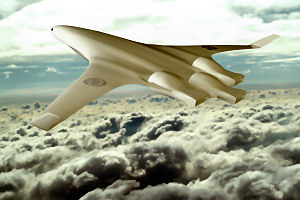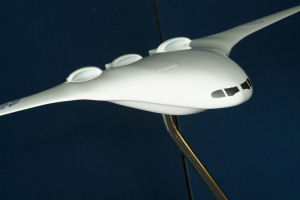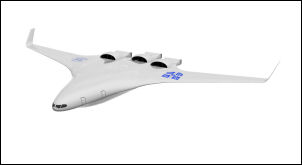The vision of quieter and more environmentally friendly flying came a step closer as researchers from the University of Cambridge and the Massachusetts Institute of Technology (MIT) unveiled their revolutionary concept for a silent aircraft.



Originally conceived as making a huge reduction in the noise experienced by people in the vicinity of airports, this highly-efficient design also offers improvements of around 25% in the fuel consumed in a typical flight compared to current aircraft.
The design is intended for the generation after next of aircraft for entry into service in 2030. The design looked at improving the airframe as well as the engines, as half of the noise from a landing plane comes from the airframe. Some of the key design features employed are:
- the overall shape of the aircraft which is a single flying wing – this allows the body to provide lift as well as the wings allowing a slower approach which reduces noise and the shape improves fuel efficiency in cruise
The research which led to the design was sponsored by the Cambridge-MIT Institute which has funded a wide range of research and educational collaborations between the two universities. The researchers formed a Knowledge Integration Community (KIC) which included staff and students from both institutions and participants from a wide range of aerospace collaborators which include regulators, airport and airline operators, aerospace manufacturers, other universities and representatives of a community group.
The KIC approach has been developed by the Cambridge-MIT-Institute and has been successfully applied in a number of research areas. It is an exciting way to address big problems – and underpins the vital nature of collaboration in achieving the potential for step-change improvements.
Colin Smith, Rolls-Royce Director of Engineering and Technology said: “The Silent Aircraft Initiative (SAI) has been a great success in bringing many stakeholders together to study what an aircraft of the future might look like if very low noise was the primary requirement”. Describing one of the clear lessons from the project he added: “The teams at Cambridge and MIT have energetically pursued their task and have considered some highly innovative ideas. The study has confirmed that the solution for extremely low noise must be a highly integrated combination of engine and aircraft design and operation”.
This team has not only focused on the design itself but their work has had impacts on education, outreach and engagement with industry. The Department's Professor Ann Dowling, who led the UK research team said: “This project has brought industry, academia and other stakeholders together around a ‘grand challenge’ that has captured the enthusiasm and imagination of all partners: there has been effective collaboration, knowledge exchange, and development of a real team approach. The students involved have learnt a lot as members of this integrated product team.”
- flaps and slats have been eliminated – these are a major source of airframe noise when a plane is landing
- the undercarriage has been simplified and its aerodynamics improved
- the engines are mounted on the top of the aircraft which screens much of the noise from the ground
- novel ultra-high bypass engines, which have variable size jet nozzles to allow slower jet propulsion during takeoff and climb for low noise. These can be optimized for maximum efficiency during cruise which requires higher jet speeds.

